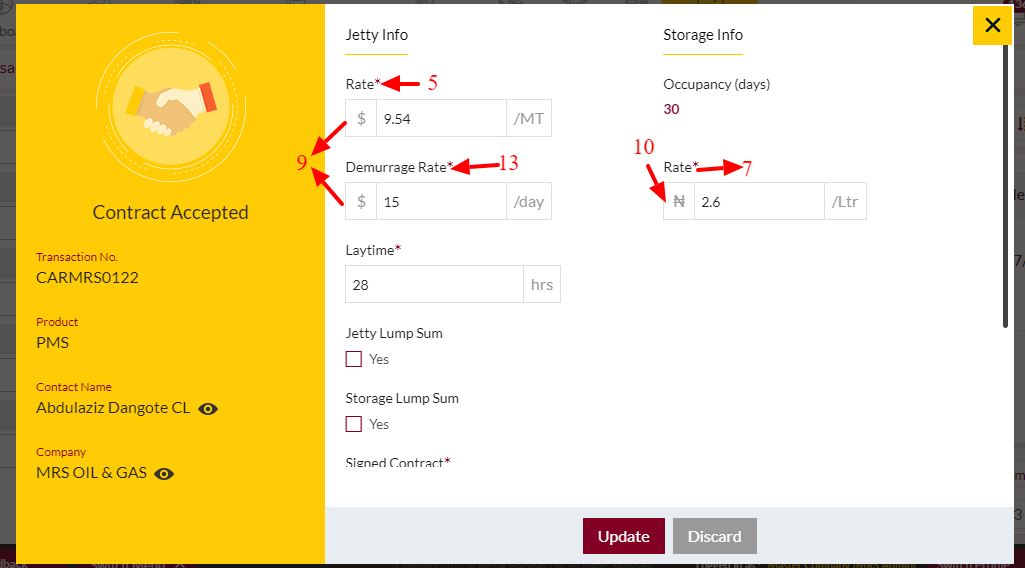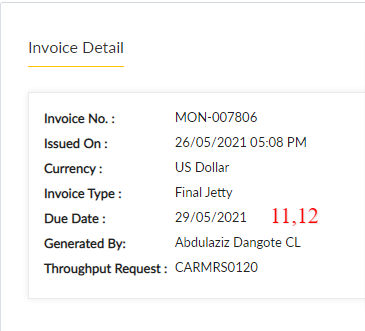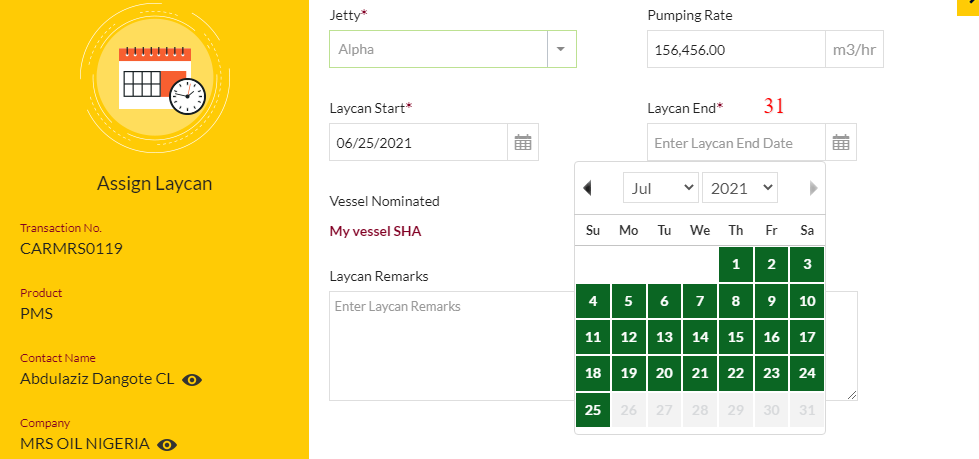TERMINAL SETTINGS
Purpose
Terminal settings are the settings which are using to control the terminal specific default configurations/settings.
1. minimum_quantity
This setting is useful to configure the minimum quantity required to place a throughput request
Display label – Minimum Request Throughput Quantity
2. maximum_quantity
This setting is useful to configure the maximum quantity allowed to place a throughput request
Display label – Maximum Request Throughput Quantity
3. delivery_terms
This setting is useful to configure the display delivery text in the LT PDF and Waybill PDFs. As of now this setting is not using. for same thing setting have been taken in company settings. That is working.
Display Label – Delivery Terms
4. address
This setting is useful to configure the address of the terminal.
Display Label – Address

5. default_jetty_rate
This setting is useful to configure the default jetty rate for the throughput request.
Display Label – Default Jetty Rate
6. default_jetty_occupancy
This setting is useful to configure the default jetty occupancy hours for the throughput request.
Display Label – Jetty Occupancy(in hours)
7. default_throughput_rate
This setting is useful to configure the default throughput rate for the throughput request.
Display Label – Default Throughput Rate
8. default_throughput_occupancy
This setting is useful to configure the default throughput occupancy days for the throughput request.
Display Label – Default Throughput Occupancy (in days)
9. default_jetty_currency
This setting is useful to configure the default jetty currency for the throughput request
Display Label – Default Jetty Currency
10. default_throughput_currency
This setting is useful to configure the default throughput currency for the throughput request
Display Label – Default Throughput Currency

11. default_jetty_invoice_due_days
This setting is useful to configure the default jetty invoice due days.
Display Label – Default Jetty Invoice Due (in days)
12. default_throughput_invoice_due_days
This setting is useful to configure the default throughput invoice due days.
Display Label – Default Throughput Invoice Due (in days)
13. default_jetty_demurrage_rate
This setting is useful to configure the default jetty demurrage rate per day.
Display Label – Default Jetty Demurrage Rate
14. default_throughput_demurrage_rate
This setting is useful to configure the default throughput demurrage rate per liter.
Display Label – Default Throughput Demurrage Rate
15. maximum_expcted_cargo_request_date
16. default_jetty_unit
This setting is useful to configure the default jetty units
Display Label – Jetty Default Units
17. default_tank_farm
This setting is useful to configure the default tank farm of the terminal to store the product.
Display Label – Default Tank Farm
18. default_throughput_unit
This setting is useful to configure the default throughput units
Display Label – Default Throughput Unit
19. default_asset_company
This setting is useful to configure the default asset owner company id.
Display Label – Default Asset Company
20. default_asset_owner
This setting is useful to configure the default asset owner user id.
Display Label – Default Asset Owner
21. default_gantry
This setting is useful to configure the default gantry for the terminal.
Display Label – Default Gantry
22. default_lat_expiry
23. default_delivery_address
24. pdf_heading
25. pdf_head_office
26. pdf_website
27. pdf_terms_conditions
28. minimum_lat_quantity
This setting is useful to configure the minimum required quantity to program a loading ticket for the terminal
Display Label – Minimum LT Quantity
29. maximum_roro_pickup_order_loading_days
30. laycan_assign_minimum_end_date_duration
Display Label – Laycan Assign Minimum End Date Duration

31. laycan_assign_maximum_end_date_duration
This setting is useful to configure the number of days allowed to select the end date of laycan.
Display Label – Laycan Assign Maximum End Date Duration
32. default_lat_demurrage_rate
33. default_lat_invoice_due_days
This setting is useful to configure the default LT invoice due days.
Display Label – Default LT Invoice Due (in days)
34. default_lat_demurrage_applied_limit
35. default_lat_checkin_time
This setting is useful to configure the LT check-in allowed duration before the loading date.
Display Label – Default LT Check-in Enable Time
36. default_lat_demurrage_fixed_rate
37. default_days_for_gantry_check_enddate
38. quantity_variance
This setting is useful to configure the quantity variance value in percentage. If the loaded quantity of a LT is having the difference within quantity variance then the stock will be adjusted in the stock account only. System will not return quantity to the customer or system will not charge for extra quantity.
Display Label – Quantity Variance Value
39. no_of_free_re_program
Display Label – Number of Free Re Program Setting
40. charges_for_re_program
This setting is useful to configure how much amount is required to charge for the re-program/editing the loading date of the LT.
Display Label – charges for Re Program Setting
41. minimum_quantity_internal_consumption
This setting is useful to configure the minimum quantity required to place an internal product request.
Display Label – Minimum Quantity For Internal Product Request
42. maximum_quantity_internal_consumption
This setting is useful to configure the maximum quantity allowed to place an internal product request.
Display Label – Maximum Quantity For Internal Product Request
43. GANTRY_NOTIFY_ME_DAYS_INTERVAL
44. DRIVER_ISSUANCE_MIN_YEAR
45. maximum_lat_quantity
This setting is useful to configure the maximum allowed quantity to program a loading ticket for the terminal
Display Label – Maximum LT Quantity
46. restrict_checkin
47. restrict_less_12_hours_checkin
48. restrict_hours_checkin
49. checkin_loading_date_start_time
50. checkin_completed_before_loading_hours
51. check_in_time_limit_setup
52. quantity_variance_fur

53. lat_expiry_date_window
This setting is useful to configure the expiry date window. Based on the configured value the expiry date will be applied according to loading date. This setting is required to provide in number of days
Display Label – LT Expiry Date Window Difference (in days)
54. lt_authentication_period
This setting is useful to configure the LT authentication period to allow the LT authentication from the loading date onwards. This setting needs to be configured in hours.
Display Label – LT Authentication Period
55. tsi_check_grace_period
This setting is useful to configure the TSI Check Grace Period, if the truck is failed TSI check at the terminal then the same truck can be taken TSI check again if the truck returned within the configured grace period.
Display Label – TSI Check Grace Settings
56. truck_compartment_variance
This setting is useful to configure the truck compartment variance value in percentage, in end batch of a loading ticket compartment value allowed more than the scheduled quantity till the configured percentage only.
Display Label – Truck Compartment Variance Value
57. quantity_variance_max_value
This setting is useful to configure the maximum quantity variance value in percentage. If the loaded quantity of a LT is more than the configured allowed percentage then the system will not allow to complete the end batch.
Display Label – Quantity Variance Maximum Value